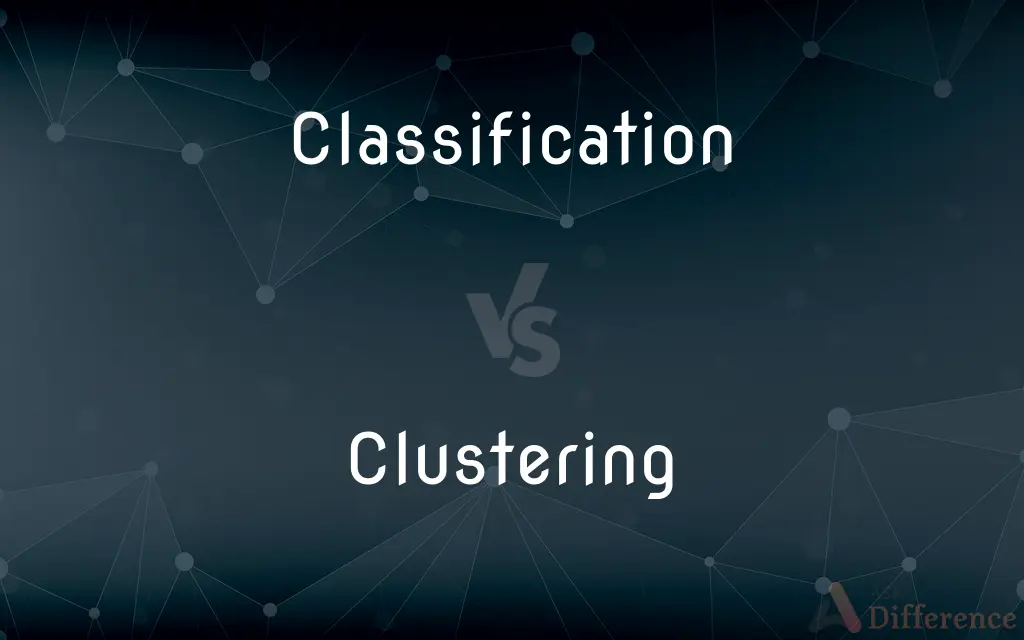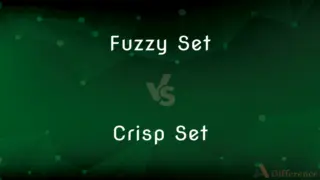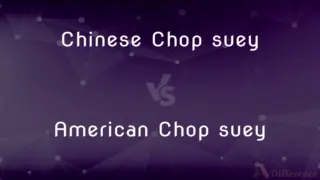Classification vs. Clustering — What's the Difference?
By Tayyaba Rehman — Published on January 4, 2024
Classification is the process of categorizing data into predefined classes, while clustering groups data based on similarity without predefined classes.

Difference Between Classification and Clustering
Table of Contents
ADVERTISEMENT
Key Differences
Classification is a supervised learning technique where the model is trained with labeled data, meaning each training example is tagged with the correct output. In clustering, a form of unsupervised learning, the algorithm groups data into clusters without any prior labeling.
In classification, the output classes are known and defined. For example, in a spam detection system, emails are classified as 'spam' or 'not spam.' Clustering, however, identifies natural groupings in data, like grouping customers based on buying behavior, where the groups are not known beforehand.
Classification algorithms need a training phase with labeled data to learn the relationship between input and output. Clustering algorithms directly analyze the data to find patterns and groupings without any training phase.
Classification is used in applications where the categories of the output are known, such as diagnosing diseases from symptoms. Clustering is employed in exploratory data analysis to discover structures or patterns in the data, like market segmentation.
Accuracy in classification is measured against the known labels of a test set, whereas in clustering, metrics like intra-cluster and inter-cluster distances are used, as there are no true labels for comparison.
ADVERTISEMENT
Comparison Chart
Learning Type
Supervised learning.
Unsupervised learning.
Data Labels
Requires labeled data.
Does not require labeled data.
Objective
Categorize into predefined classes.
Group based on similarity without set classes.
Application
Known categories (e.g., spam detection).
Discovering patterns or groupings.
Evaluation
Accuracy measured against known labels.
Measured by intra-cluster cohesion.
Compare with Definitions
Classification
Classification involves training a model to assign labels to data points.
The software classified loan applications as 'approved' or 'rejected.'
Clustering
It identifies patterns or structures in unlabeled data sets.
The clustering algorithm grouped genes with similar expression patterns.
Classification
It's a process of identifying the category to which new observations belong.
The AI system classified the new image as a 'cat.'
Clustering
Clustering does not use predefined categories or labels.
Clustering grouped the stars into different galaxies based on their properties.
Classification
It uses labeled data to learn the characteristics of different classes.
The algorithm classified patients as 'high risk' or 'low risk' for the disease.
Clustering
Clustering is grouping data points based on similarity or common features.
The algorithm clustered the documents based on topic similarities.
Classification
Classification is categorizing data into predefined groups.
The email was classified as spam by the filtering system.
Clustering
A group of the same or similar elements gathered or occurring closely together; a bunch
"She held out her hand, a small tight cluster of fingers" (Anne Tyler).
Classification
Classification is used for decision-making based on learned data attributes.
Based on classification, the system recommended specific ads to the user.
Clustering
(Linguistics) Two or more successive consonants in a word, as cl and st in the word cluster.
Classification
The act, process, or result of classifying.
Clustering
A group of academic courses in a related area.
Classification
A category or class.
Clustering
To gather or grow into bunches.
Classification
(Biology) The systematic grouping of organisms into categories on the basis of evolutionary or structural relationships between them; taxonomy.
Clustering
To cause to grow or form into bunches.
Classification
The act of forming into a class or classes; a distribution into groups, as classes, orders, families, etc., according to some common relations or attributes.
Clustering
A grouping of a number of similar things.
Classification
The act of forming into a class or classes; a distribution into groups, as classes, orders, families, etc., according to some common relations or affinities.
Clustering
(demographics) The grouping of a population based on ethnicity, economics or religion.
Classification
The act of distributing things into classes or categories of the same type
Clustering
(computing) The undesirable contiguous grouping of elements in a hash table.
Classification
A group of people or things arranged by class or category
Clustering
(writing) A prewriting technique consisting of writing ideas down on a sheet of paper around a central idea within a circle, with the related ideas radially joined to the circle using rays.
Classification
The basic cognitive process of arranging into classes or categories
Clustering
Forming a cluster.
Classification
Restriction imposed by the government on documents or weapons that are available only to certain authorized people
Clustering
Present participle of cluster
Clustering
A grouping of a number of similar things;
A bunch of trees
A cluster of admirers
Clustering
It's an unsupervised method for finding natural groupings in data.
Clustering revealed distinct customer segments in the market analysis.
Clustering
Clustering is often used for exploratory data analysis.
Clustering helped in identifying the main themes in the survey responses.
Common Curiosities
What is Classification in data analysis?
Classification involves categorizing data into predefined groups based on learned patterns.
How does Clustering differ from Classification?
Clustering groups data based on similarities without predefined classes, unlike Classification.
Is Classification a supervised learning technique?
Yes, Classification is a supervised learning technique requiring labeled training data.
Can Classification be used without labeled data?
No, Classification requires labeled data for training the model.
What type of learning is Clustering considered?
Clustering is an unsupervised learning method.
How is Clustering applied in the real world?
Clustering is used in market segmentation, social network analysis, and astronomical data analysis.
What metrics are used to evaluate Clustering algorithms?
Clustering algorithms are evaluated using metrics like silhouette score or intra-cluster distance.
Can Classification predict continuous outcomes?
No, Classification predicts categorical outcomes; for continuous outcomes, regression is used.
How do you measure the accuracy of a Classification model?
The accuracy of a Classification model is measured against a test set with known labels.
Is it possible to use both Classification and Clustering in the same project?
Yes, both can be used complementarily, like using Clustering for data exploration before Classification.
Is Clustering useful for finding patterns in data?
Yes, Clustering is effective for discovering natural patterns and groupings in data.
What are some common uses of Classification?
Classification is commonly used in spam detection, medical diagnosis, and sentiment analysis.
Does Clustering require a training phase?
No, Clustering does not require a training phase as it's unsupervised learning.
Are there different types of Classification algorithms?
Yes, there are various types, including decision trees, support vector machines, and neural networks.
Can Clustering be used for image segmentation?
Yes, Clustering can be used for segmenting images based on pixel similarities.
Share Your Discovery

Previous Comparison
Fuzzy Set vs. Crisp Set
Next Comparison
Chinese Chop suey vs. American Chop sueyAuthor Spotlight
Written by
Tayyaba RehmanTayyaba Rehman is a distinguished writer, currently serving as a primary contributor to askdifference.com. As a researcher in semantics and etymology, Tayyaba's passion for the complexity of languages and their distinctions has found a perfect home on the platform. Tayyaba delves into the intricacies of language, distinguishing between commonly confused words and phrases, thereby providing clarity for readers worldwide.
















































